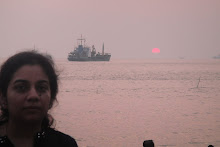
Shweta Mohapatra - a graduate from NID (National Institute of Design), Ahmedabad, and a post-diploma holder from PASCA (Pont-Aven School of Contemporary Arts), France.
Hmm..Let’s see. In 2005 after I graduated, I was working as a freelance television promo producer, in Mumbai. A friend of mine, Hema Nazerath, had illustrated for ILFS, School Net. She suggested that I should show them my sketches, so I did and they gave me to do my first book. ‘Marrima’s Rag Doll’ this was a UNICEF book, after that I went on to do 4 more books for them, and that’s how I started illustrating for children’s book.

2. What inspires you most to unleash your creativity?
That’s a tough one, but I think there is so much around us and to soak in and take it in. Visually it could be anything like something out of popular culture iconography, various Indian art forms, something I see on the Internet, magazine etc.
3. How do you select the projects - you must be having some favourite topics
which you want to do but some different kind are offered to you by publishers. How do you strike a balance between the two?
I am glad you asked this question; the problem here in India is that there is no cohesiveness in children book publication (except a very few houses). The editor gets a story makes a call to the art dept. the art dept looks for various style and then gives this out to the illustrator, a dtp gu y puts text images together and your book is ready. I feel as in illustrator there is not much say. Also editors tend to judge too quickly looking for various illustrators only as ‘various style’ rather than as storytellers. Very few publishing houses will do ‘only picture’ books. I doodle, sketch and write sometime. I do not know if I strike a balance, I would like to do that but I don’t think I do.
y puts text images together and your book is ready. I feel as in illustrator there is not much say. Also editors tend to judge too quickly looking for various illustrators only as ‘various style’ rather than as storytellers. Very few publishing houses will do ‘only picture’ books. I doodle, sketch and write sometime. I do not know if I strike a balance, I would like to do that but I don’t think I do.
4. Which books, illustrations and illustrator do you find impressive?
Oh wow, many many but not necessarily illustrators only, artists, graphic designers, animators, patachitra/miniature artists, photographers, filmmakers. Growing up in the 80’s I grew up with my fair share of Victor Dragunsky, Rojan, Marvel comics- (phantom, Manderek , Flash Gordon) Tinin and Amar Chitra Katha, so these are all time favorites . Some Children’s illustrated books I love- Persipolis by Marjane Satrapi (though technically it’s a Graphic Novel), All books of David Weisner, Today is my day by Piet Grobler. Swimmy by Leo Leoni, Harold and the Purple Crayon by Crockett Johnson, Cat in the Hat, And To Think I Saw It On Mulberry Street by Dr. Seuss. Madeline by Ludwig Bemelmans and many more.
5. Did you have any formal training in this field? Do you think its necessary to have some basic training?
I went to National Institute of Design (NID, Ahmedabad), and graduated in animation  filmmaking, more recently I went on to do my post-baccalaureate in contemporary art. I never really trained as an Illustrator, but had a very strong background in visual communication and drawing. I do not think one needs to have institutionalized training in illustration, but one needs to have the enthusiasm for drawing, story telling and have a good imagination.
filmmaking, more recently I went on to do my post-baccalaureate in contemporary art. I never really trained as an Illustrator, but had a very strong background in visual communication and drawing. I do not think one needs to have institutionalized training in illustration, but one needs to have the enthusiasm for drawing, story telling and have a good imagination.
6. What advice would you like to offer to aspiring illustrator?
If one is illustrating for children one needs to be playful in putting the illustration together, if they have stories/ideas that they want to say, just start drawing. They have to get their work out there for everyone to see, start a blog, website. It might not be easy to get a first project, but organize your work well.
7. What are your next projects coming up?
I am off to Raghurajpur, a small artist’s village near the coastal town of Puri in Orissa, I shall be working with some artisans there and hopefully will be able to take it forward from there. Right now it’s open ended; it could end up as a book, animation film or products.

Shweta, a big thanks for sharing your views with us...
Links




 He is working with 'Katha' on some of the forthcoming children's titles and was also in Delhi to judge the Katha Chitrakala contest - a
He is working with 'Katha' on some of the forthcoming children's titles and was also in Delhi to judge the Katha Chitrakala contest - a 













.png)








